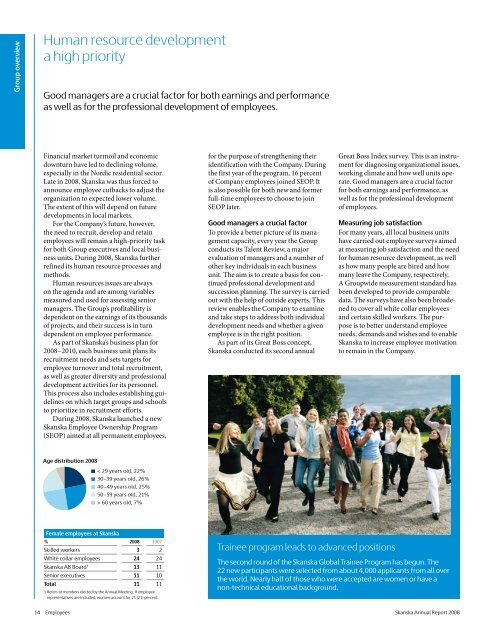Annual Report 2008 - Skanska
Annual Report 2008 - Skanska
Annual Report 2008 - Skanska
You also want an ePaper? Increase the reach of your titles
YUMPU automatically turns print PDFs into web optimized ePapers that Google loves.
Group overview<br />
Human resource development<br />
a high priority<br />
Good managers are a crucial factor for both earnings and performance<br />
as well as for the professional development of employees.<br />
Financial market turmoil and economic<br />
downturn have led to declining volume,<br />
especially in the Nordic residential sector.<br />
Late in <strong>2008</strong>, <strong>Skanska</strong> was thus forced to<br />
announce employee cutbacks to adjust the<br />
organization to expected lower volume.<br />
The extent of this will depend on future<br />
developments in local markets.<br />
For the Company’s future, however,<br />
the need to recruit, develop and retain<br />
employees will remain a high-priority task<br />
for both Group executives and local business<br />
units. During <strong>2008</strong>, <strong>Skanska</strong> further<br />
refined its human resource processes and<br />
methods.<br />
Human resources issues are always<br />
on the agenda and are among variables<br />
measured and used for assessing senior<br />
managers. The Group’s profitability is<br />
dependent on the earnings of its thousands<br />
of projects, and their success is in turn<br />
dependent on employee performance.<br />
As part of <strong>Skanska</strong>’s business plan for<br />
<strong>2008</strong>−2010, each business unit plans its<br />
recruitment needs and sets targets for<br />
employee turnover and total recruitment,<br />
as well as greater diversity and professional<br />
development activities for its personnel.<br />
This Åldersfördelning process also <strong>2008</strong> includes establishing guidelines<br />
on which target < 29 groups år, 22% and schools<br />
to prioritize in recruitment 30–39 år, efforts. 26%<br />
During <strong>2008</strong>, <strong>Skanska</strong> 40–49 år, launched 25% a new<br />
<strong>Skanska</strong> Employee Ownership 50–59 år, 21% Program<br />
(SEOP) aimed at • all > permanent 60 år, 7% employees,<br />
for the purpose of strengthening their<br />
identification with the Company. During<br />
the first year of the program, 16 percent<br />
of Company employees joined SEOP. It<br />
is also possible for both new and former<br />
full-time employees to choose to join<br />
SEOP later.<br />
Good managers a crucial factor<br />
To provide a better picture of its management<br />
capacity, every year the Group<br />
conducts its Talent Review, a major<br />
evaluation of managers and a number of<br />
other key individuals in each business<br />
unit. The aim is to create a basis for continued<br />
professional development and<br />
succession planning. The survey is carried<br />
out with the help of outside experts. This<br />
review enables the Company to examine<br />
and take steps to address both individual<br />
development needs and whether a given<br />
employee is in the right position.<br />
As part of its Great Boss concept,<br />
<strong>Skanska</strong> conducted its second annual<br />
Great Boss Index survey. This is an instrument<br />
for diagnosing organizational issues,<br />
working climate and how well units operate.<br />
Good managers are a crucial factor<br />
for both earnings and performance, as<br />
well as for the professional development<br />
of employees.<br />
Measuring job satisfaction<br />
For many years, all local business units<br />
have carried out employee surveys aimed<br />
at measuring job satisfaction and the need<br />
for human resource development, as well<br />
as how many people are hired and how<br />
many leave the Company, respectively.<br />
A Groupwide measurement standard has<br />
been developed to provide comparable<br />
data. The surveys have also been broadened<br />
to cover all white collar employees<br />
and certain skilled workers. The purpose<br />
is to better understand employee<br />
needs, demands and wishes and to enable<br />
<strong>Skanska</strong> to increase employee motivation<br />
to remain in the Company.<br />
Age distribution <strong>2008</strong><br />
< 29 years old, 22%<br />
30–39 years old, 26%<br />
40–49 years old, 25%<br />
50–59 years old, 21%<br />
• > 60 years old, 7%<br />
Female employees at <strong>Skanska</strong><br />
% <strong>2008</strong> 2007<br />
Skilled workers 3 2<br />
White collar employees 24 24<br />
<strong>Skanska</strong> AB Board 1 13 11<br />
Senior executives 11 10<br />
Total 11 11<br />
1 Refers to members elected by the <strong>Annual</strong> Meeting. If employee<br />
representatives are included, women account for 21 (21) percent.<br />
Trainee program leads to advanced positions<br />
The second round of the <strong>Skanska</strong> Global Trainee Program has begun. The<br />
22 new participants were selected from about 4,000 applicants from all over<br />
the world. Nearly half of those who were accepted are women or have a<br />
non-technical educational background.<br />
14 Employees <strong>Skanska</strong> <strong>Annual</strong> <strong>Report</strong> <strong>2008</strong>

















